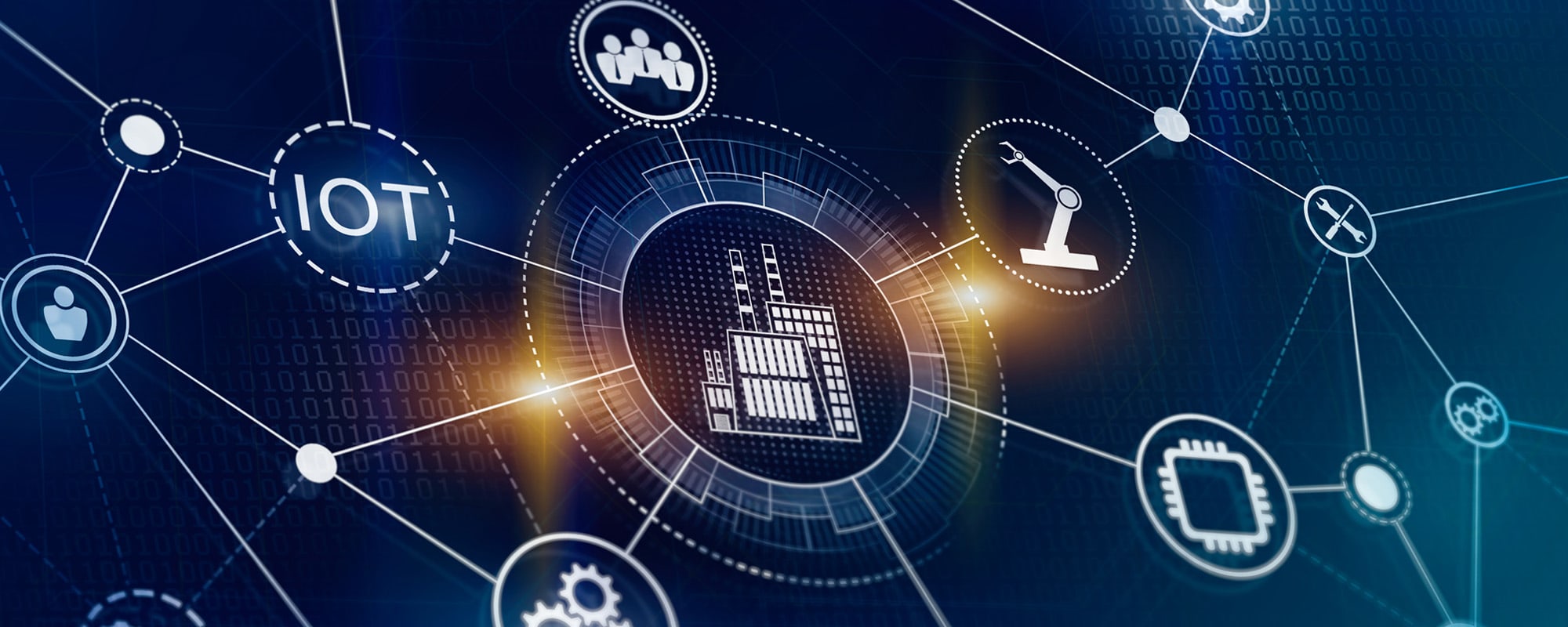The industrial market is experiencing a digital transformation catalyzed by Industry 4.0 trends and technologies, the benefits of which are helping organizations in every industrial sector overcome pervasive market challenges, including downtime, skilled labor shortages, and inefficiencies. Learn more about these challenges and solutions, how they’re impacting the rapidly evolving energy and utilities sector, and the products essential to making ambitious modernization goals with impending deadlines a reality in this three-part series.
Mark Russell, Technical Application Support Manager, RS
In this third and final installation of our three-part series, you’ll learn how to leverage Industry 4.0 trends and technologies in the energy and utilities sector to overcome pervasive challenges and achieve modernization goals. Missed part two? Click here to learn more about the impact of Industry 4.0 trends and technologies on the energy and utilities sector and its ambitious modernization goals. Missed part one? Click here to learn about the Industry 4.0 trends and technologies helping industrial market sectors eliminate unplanned downtime and overcome skilled labor shortages.
Implementing Industry 4.0 Trends and Technologies in the Energy and Utilities Sector
Digitalization — or the process of transforming manual system and process controls to digital systems and processes executed using computers and the internet — is essential to modernizing the energy and utilities sector. It makes our electrical generation and transmission network more flexible and decentralized and supports the industrial market and increasingly worldwide trend toward electrification. Smart Industry 4.0 solutions, including automation, IIoT, and industrial networking technologies, are essential to digitalization. In fact, a 2020 report about digital transformation in the energy industry found that digital technologies enabled a 2–10% improvement in energy production and boosted cost efficiency by 10–30%.
Condition monitoring solutions, like smart meters and IIoT sensors, for instance, enable employees to remotely monitor the status and performance of energy production and transmission equipment and processes and collect and transmit real-time information about energy usage, voltage fluctuations, and outages. Remote condition monitoring is especially advantageous in sprawling energy and utility facilities, remote installations, like solar and wind farms, and areas prone to natural disasters more quickly, efficiently, safely, and accurately than manual inspections. As such, it saves energy and utility companies time and labor costs, allows them to utilize onsite employees for more complex tasks, and supports predictive maintenance strategies that help eliminate unplanned downtime. Smart meters and IIoT sensors also enable smart grids capable of managing and balancing the intermittent flow of renewable energy and integrating it into the electrical grid, which boosts energy efficiency and reliability, makes renewable energy more accessible, which in turn helps fuel adoption, and can even help reduce energy costs.
Other applications of IIoT sensors crucial to supporting the sector- and industry-wide electrification and digitalization trends include remotely monitoring, troubleshooting, and optimizing the performance of energy storage systems that utilize fire-prone lithium batteries, as well as monitoring and managing bidirectional grid systems, such as vehicle-to-grid (V2G) smart charging technology, which treats high-capacity EV batteries as backup storage cells for the electrical grid as well as tools to power EVs to better manage demand.
Sensors equipped with IO-Link communication capabilities are especially well suited for use in modern energy and utility applications like these because they’re plug-and-play, which simplifies and hastens the installation process, eliminates the need for manual configuration, reduces the need for specialist expertise, reduces wiring quantities and complexity, and results in significant cost savings. They also enable real-time monitoring and diagnostic status updates that facilitate the quick identification and resolution of any issues before they become critical, which reduces downtime and maintenance costs and increases efficiency and productivity.

The JN2201 inclination sensor from ifm efector is a good example. Optimized for mobile and industrial applications, these devices provide high-precision angle of inclination measurements in two axes, offer flexible outputs, including IO-Link communication, and have compact, robust housings optimized for use in harsh industrial environments. JN2201 inclination sensors feature rugged, nickel-plated diecast zinc housings with IP65, IP67, IP68, and IP69K sealing and optional protective covers and reliably resist electromagnetic interference (EMI), shock, vibration, salt spray, and damp heat. They’re also rated for operating temperatures extending from -40°C to +85°C and equipped with temperature compensation capabilities to minimize the impact of temperature changes on sensor measurements to ensure high accuracy and exhibit a mean time to failure of 176 years.

SICK AHS/AHM36 IO-Link absolute encoders are another good example. Absolute encoders are linear or rotary devices that use a sensor to measure the position, direction, and speed of a rotating shaft or axle and convert the angular position or motion to analog or digital output signals. These encoders are small, adaptable, rugged, economical, fully magnetic, and ideal for a wide range of harsh environment applications in higher-level networks. They have compact IP67- or IP69K-rated stainless steel form factors with rotatable M12 connectors or cable connections, maximum 14-bit single-turn or 26-bit multi-turn resolutions, and various mounting hole patterns, adapter flanges, and shaft diameters to enable quick, easy, and flexible installation and extreme environmental resistance. Their IO-Link interface enables quick, easy, and economical integration into Ethernet and fieldbus networks, and they’re quick and easy to configure using an IO-Link master or the SICK SOPAS engineering tool. CANopen, SAE J1939, and SSI interfaces are also available. Other features that make SICK ASH/AHM36 IO-Link encoders ideal for modern energy and utility applications include intelligent diagnostic functions, limit value monitoring capabilities that can evaluate maintenance intervals for the entire system, a configurable input/output pin for additional communication capabilities, configurable smart tasks engineered to take over functions of the higher automation level, and an operating temperature range extending from -40°C to +85°C.
Asset management solutions, like PLCs and edge and cloud computing systems, also play a vital role in helping energy and utility organizations implement Industry 4.0 trends that can help resolve industry- and sector-specific challenges. PLCs, for instance, have long been the crux of automated process systems. They receive sensor data from I/O modules and systems, send programmed responses based on those sensor inputs to output devices capable of affecting the process, such as pumps, heaters, and actuators, and are especially well suited for use in particularly harsh environments due to the widespread availability of ultra-rugged form factors.
I/O modules typically transmit information from a single I/O point to a PLC, while I/O systems typically feature higher channel densities and additional features, like diagnostics, ideal for more complex application environments.

The Siemens Simatic ET 200SP MultiFieldbus I/O system is flexible, multifunctional, scalable, safe, and reliable. It is very easy to install, extremely user-friendly, particularly compact, and ideal for use in new and modernizing energy and utility operations. This is especially true given increasingly high control cabinet densities, rapidly evolving automation systems, and a limited supply of skilled laborers. These modules are about 50% narrower than comparable distributed I/O systems, which helps optimize space in control cabinets and decentralized control boxes. They support up to 16 channels and deliver powerful performance as well as integrated safety and diagnostic functions that reduce downtime. Additionally, they feature a multi-hot-swapping function that allows operators to swap out modules during operation and automatically transfer relevant parameters to avoid downtime.
Their unique MultiFieldbus design supports versatile bus connection technologies, including FastConnect, fiber optic, and M12; easy programming without an engineering system via the MultiFieldbus Configuration Tool; and the three most common communication protocols — PROFINET, Modbus TCP, and EtherNet/IP — using the same I/O station, which simplifies network architectures and cuts costs. This system also offers a wide range of modules optimized to suit applications including energy meters, motor starters, pneumatics, and motor drives. IO-Link communication modules are also available. And while the Simatic ET 200SP MultiFieldbus I/O system is only rated IP20, since it’s designed for use in control cabinets, it satisfies EMI and noise immunity standards and is even available in ATEX- and IECEx-certified explosion-proof variants ideal for use in applications including energy storage systems, as well as in SIPLUS ET200SP variants rated for operating temperatures extending from -40° to +70°C and applications with aggressive atmospheres.

Advantech ADAM-6000 Series remote I/O modules are another great option for energy and utility applications. These smart Ethernet I/O modules are empowered by Peer-to-Peer (P2P) and Graphic Condition Logic (GCL) and designed to perform as either standalone measurement, control, and automation products or easily integrate into Ethernet networks to remotely monitor device status. They support cloud management configuration, monitoring, and firmware updates that reduce the need for onsite personnel and have a built-in web server and data stream function to transmit data for processing in support of equipment and process optimization. For example, when installed as an add-on system for power generators, their device-to-cloud equipment management capability diminished the need for the more intermittent (and therefore less effective) onsite patrols previously used to monitor them. Capabilities including real-time status updates about characteristics, such as operating temperatures and power signals, and cloud control allowed operators to immediately respond to errors, such as switch signals and warning lights, which made it significantly easier to reliably avoid equipment damage and downtime.
Edge and cloud computing systems perform a similar role but enable more complex calculations, sequencing, and analytics and greater network connectivity, programming flexibility, and scalability. They do, however, tend to cost more and, while they are readily available in ruggedized versions, tend not to offer the same ultra-rugged characteristics as many PLCs do. These systems analyze the data collected and transmitted by IIoT and industrial networking technologies to help energy and utility organizations optimize processes and maximize efficiencies. They also help pinpoint potential equipment issues before they cause failures, allowing operators to schedule maintenance when the requisite parts and personnel are available to minimize downtime, and enable operators to make remote adjustments to machines and processes, which is especially beneficial in the remote and hazardous environments common in the energy and utilities industry. And all these advantages help energy and utility organizations contend with skilled labor shortages since they deliver detailed, accurate, real-time analytics that support data-driven decision-making in user-friendly formats and can often be accessed remotely, enabling offsite personnel to review the data and make decisions that don’t already have automatic responses programmed.
And industrial data communications products, like switches, gateways, routers, and protocol converters, are critical enablers for all of these other advanced Industry 4.0 technologies — facilitating the secure, real-time transmission of data that fuels optimization, productivity, efficiency, quality, safety, and profitability improvements.

Phoenix Contact’s FL 1000 Series unmanaged switches, for example, feature enhanced data traffic prioritization capabilities that are compatible with PROFINET and EtherNet/IP automation networks and designed to enhance network stability and increase system availability. Additional characteristics include plug-and-play functionality, which makes them extremely quick and easy to install and commission, and LED indicators for at-a-glance status communication to boost error response times. Multiple installation options — including a unique accessory that allows installers to flush-mount them on DIN rails and enables their use in small control panels where space is at a premium — provide added flexibility. These IP30 unmanaged switches also support a variety of data transmission speeds and environmental resiliency characteristics, including ATEX- and IECEx-certified explosion-proof variants.

Red Lion’s FlexEdge modular IIoT gateways aggregate data from multiple smart devices, sensors, and IIoT modules and send it to the cloud and are a key part of the FlexEdge Intelligent Automation Platform. This platform provides industrial organizations with the comprehensive, scalable access they need to bridge their current manufacturing and production systems with older equipment that uses legacy data protocols so they can take full advantage of the industrial data embedded in their operations. It also enables fast, efficient deployment in existing networks with an all-in-one programming environment that eliminates multiple configuration tools. It delivers power data access capabilities that support real-time monitoring and improved control and operational performance. The FlexEdge platform also includes trusted cybersecurity features that help keep critical systems up and running. The FlexEdge gateways have a future-proof modular design that allows users to add field-installable sleds as requirements change or new communication standards emerge, making it quick and easy to configure secure communications or robust automation capabilities. They also have several HazLoc certifications that make them
well suited for use in harsh environment energy and utility applications, including ABS, ATEX/IECEx, and UL Class 1, Division 2 certifications. Additional features include support for more than 300 industrial drivers and IIoT cloud connectors as well as compatibility with almost every PLC and industrial equipment brand. These gateways also offer built-in data logging, virtual HMI, and advanced web server capabilities. They also come with a variety of security features, including VPN client/server capabilities with certificate generation and real-time data, event, and security logging with cryptographic signature support.

Moxa’s EDR-810 Series industrial routers are also well suited for modern, more electrified and digitized energy and utility applications. These highly integrated, multiport routers are engineered to provide an electronic security perimeter that reliably protects Ethernet-based cyber assets in critical remote monitoring and control networks, including pump-and-treat systems in water stations, distributed control systems in oil and gas applications, and PLC and SCADA systems in facility automation applications. Integrated cybersecurity features include firewall policies that control network traffic between different trust zones; network address translation (NAT), which shields the internal LAN from unauthorized activity by outside hosts; and virtual private networks (VPNs), which provide several benefits. For example, VPNs use IP security (IPsec) servers or client mode to encrypt and authenticate all IP packets at the network layer, ensure confidentiality and sender authentication, and provide users with secure communication tunnels when accessing a private network from the public internet. Moxa’s EDR-810 Series routers have a WAN Routing Quick Setting that requires just four easy steps to set up WAN and LAN ports and create a routing function. They also have a Quick Automation Profile that gives engineers an easy way to configure
the firewall filtering function using general automation protocols, including EtherNet/IP, Modbus TCP, EtherCAT, FOUNDATION Fieldbus, and PROFINET. Additional features include a user-friendly web-based user interface (UI) that makes it easy to create a secure Ethernet network with a single click, deep Modbus TCP packet inspection capabilities, standard and wide-temperature variants rated for -10°C to +60°C and -40°C to +75°C, respectively, and a rugged design certified to relevant EMI, shock, vibration, freefall, industrial cybersecurity, marine, and ATEX standards.
RS: Your Trusted Partner for Leveraging Industry 4.0 in the Energy and Utilities Sector
RS is well experienced in helping energy and utility organizations navigate the complexities of industrial market challenges, ranging from downtime and skilled labor shortages to inefficiencies. We help organizations embrace Industry 4.0 trends — including electrification, digitalization, automation, remote condition monitoring, and predictive maintenance — and implement advanced Industry 4.0 technologies, ranging from sensors and IIoT networks to asset management solutions and industrial data communications products.
Our experienced customer support — which spans the design, build, and maintenance phases — is backed by the breadth and depth of our product offerings and enhanced by our omnichannel ease of doing business.
For more information about the RS portfolio of energy and utility sector solutions, including renewable energy solutions, please visit the embedded links throughout this article. For assistance selecting, procuring, deploying, and maintaining products that can help improve the optimization, efficiency, productivity, quality, safety, and profitability of your energy and utilities industry assets, please contact your local RS representative at 1.866.433.5722 or reach out to our technical product support team.






